This page is a translation of the document (in PDF format)
Verkehrssicherheit in Einbahnstra�en mit gegengerichtetem Radverkehr
Top: Home Page
Up: Table of Contents
![]() Auch auf
deutsch erh�ltlich!
Auch auf
deutsch erh�ltlich!
This page is a translation of the document (in PDF format)
Verkehrssicherheit
in Einbahnstra�en mit gegengerichtetem Radverkehr
Alrutz, D./ Angenendt, W./ Draeger, W./ Gündel, D.
In: Straßenverkehrstechnik, 6/2002
Translation by John S. Allen
who accepts responsibilty for any errors of translation
Posted by permission
1. Existing conditionsUrban one-way streets serve primarily to channel and regularize motor traffic. For bicycle traffic, on the other hand, they interrupt many direct connections and make the use of low-traffic local streets more difficult, leading bicyclists to travel illegally on one-way streets in the wrong direction, or to move over to parallel arterial streets. The topic of opening one-way streets to contraflow bicycle traffic was controversial for years in Germany (see. DRAEGER 1997). Questions about the effect on traffic safety and of the proper approach under the traffic laws led local governments to various solutions, or generally to avoid contraflow installations. Contraflow sidepaths and, less often, bike lanes, have, however, been installed in some places for decades. In many places, the "false one-way street" solution has been most widely used, mainly to avoid problems of conformity with the traffic law. Before 1997, some cities nonetheless opened true one-way streets to contraflow bicycle traffic, at least in some selected districts, by way of exceptional applications of the traffic law. Figure 1 illustrates these. These developments, and the mostly positive experience to date, led to a provision in an amendment to the traffic law (StVO) that went into effect on September 1, 1997, allowing contraflow bicycle travel on one-way streets under certain conditions. The provisions in the StVO and in rules for application of the StVO (VwV-StVO) for opening of one-way streets were, however, not put into effect until December 31, 2000, due to lack of sufficient research support. Experimental evidence was to be collected to determine whether, all in all, and particularly as they affect traffic safety, such measures are justifiable. |
Figure 1: Main ways of opening one-way streets to contraflow bicycle traffic
| 1. Sidepath | 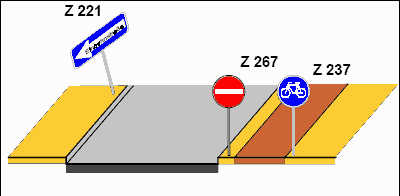 |
| 2. Bike lane | 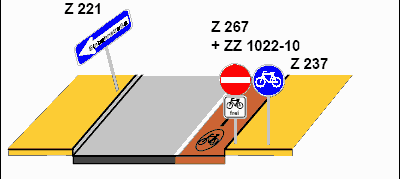 |
| 3. Bicycle street | 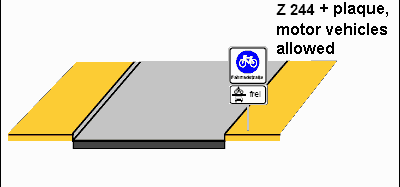 |
| 4. False one-way street | 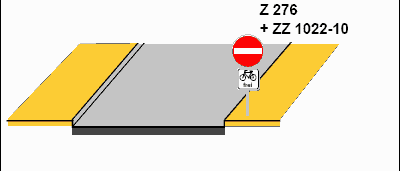 |
| 5. One-way street as in the 1997 amendment to the traffic law | 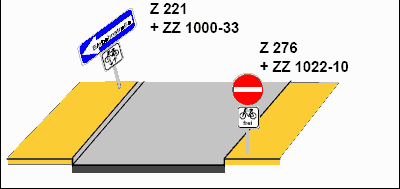 |
| The goal of the research plan of the Federal Road Research Institute (Bundesanstalt
f�r Stra�enwesen), completed in 2000 (PGV/BIS 2001) was to look more deeply into the
issue of traffic safety on one-way streets where contraflow bicycle traffic was permitted
according to the new StVO provision, and to evaluate these streets in comparison with
other one-way streets where contraflow bicycle traffic was prohibited. In this way, a
well-founded decision could be reached as to whether the experimental provisions could
stand after the year 2000, and whether modifications to them should be recommended. In what follows here, the most important results and conclusions from the research are reported. These have already led to a permanent status for the StVO provision. 2. Research phases
Recommendations for amendments to the law and for measures that might be taken in order to make contraflow travel on one-way streets safe, were discussed with experts, i.e., in the context of work of committees of the Road and Traffic Research Society (Forschungsgesellschaft f�r Stra�en und Verkehrswesen). 3. Conclusions of researchAmendment to the law and its reception by the municipalitiesDuring the research phase, many cities and towns were wary of opening one-way streets. In part, they feared having to undo measures that had already been put into place, in case the new provision was not made permanent. But there were other reasons as well:
Many municipalities began to open one-way streets in the network of local streets immediately after the amendment. An area-wide opening, however, was only carried out in one case. The documentation and evaluation of traffic and crash situations required in the rules for application of the traffic law are only rarely fully carried out by the authorities responsible for the streets. Only one example of withdrawal of an opening of a one-way street because of crashes involving contraflow bicycle traffic is known. Results of the counts and behavioral observationsDepending on their location in the street network, one-way streets in 30 km/hour zones carry as many as 220 motor vehicles and 140 bicyclists per hour. As a rule, however, the traffic volumes are significantly lower. In the one-way streets which have been opened, 40 – 45% of the bicyclists, on average, travel in the contraflow direction. This quantity is not significantly lower in the one-way streets which have not been opened; however, many more bicyclists traveling in the contraflow direction use the sidewalks (60% as opposed to approximately 20% in opened one-way streets, see figure 2). For pedestrians, then, there were markedly fewer restrictions and hazards on the sidewalk. Opening a one-way street also can shift bicycle traffic from main streets to local streets. |
Figure 2: Distribution of contraflow
bicycle traffic
with respect to traffic rules and location of bicyclists.

| Motorists reduce their speeds significantly when encountering bicyclists if a street
is less than 3.50 m wide. Even when the street is narrow, the encounters are problem-free,
because visual contact is good. When the streets are wider, the shy distance between
bicyclists and motor vehicles increases, but the motor vehicles also travel faster. Critical conflicts between motor vehicles and bicyclists in the one-way direction are more frequent than with bicyclists in the contraflow direction. Besides overtaking maneuvers, stationary vehicles are the most important cause of problems. Pedestrians, on the other hand, more commonly get into critical conflicts with bicyclists in the contraflow direction. These conflicts were, however, mainly caused by the pedestrians, who came from the right out of view of the contraflow bicyclists and failed to notice the bicyclists when crossing. These problems are most common in streets heavily used for business trips. Behaviors of motorists and bicyclists at intersections with priority to the right range from a very cautious approach to a bold entry and passage through the intersection without any reduction in speed. Some turning movements involve "cutting corners", even when sight conditions are poor. Motor vehicles illegally parked near the intersection sometimes worsen the sight conditions. Results of the crash analysisIn general, very few bicycle crashes occur in zones with a 30 km speed limit. More than 80% of the 669 streets had no crashes during the 3- to 4-year observation period. Only 3% of the streets had more than one crash (Figure 3). In the comparison between the one-way streets opened as provided in the StVO (669 segments) and those which were not opened, the crash densities were equal. The crash densities for one-way streets in 30 km/h zones were below those for nearby two-way streets (Figure 4). Following the opening, the crash densities even decreased slightly (Figure 5). The severity of the crashes also decreased. It was no worse for contraflow bicycle traffic on streets opened as provided in the StVO than for bicycle traffic traveling in the one-way direction. |
Figure 3: distribution of crashes on the
streets
in the test area during the 3- or 4-year
experimental period

Figure 4: Crash densities with respect to the type of installation

Figure 5: Before-and-after comparison of crash numbers

| Crashes in which bicycles and motor vehicles are traveling in opposite directions are
rare on one-way streets opened as provided in the StVO, but represent a larger fraction on
one-way streets which have not been opened. Safety problems were still most common at
intersections (including those where the rule of priority for traffic on the right
applies), involving motor vehicles turning onto or crossing the one-way streets –
often in connection with sight lines restricted by parked vehicles. Motor vehicle drivers
here appear often not to have anticipated bicyclists traveling opposite the one-way
traffic. Parked vehicles between intersections have no recognizable effect on safety of
contraflow bicycle traffic. Bicyclists traveling with the one-way traffic have a larger
proportion of crashes involving parked vehicles. Crashes on the sidewalks, and generally
with pedestrians, occur less often when one-way streets have been opened, and so the
safety (and the quality of travel and of waiting) for pedestrians is improved. The percentage of children and youth (up to age 17) involved in crashes while riding in the contraflow direction is significantly higher on streets which have not been opened. On streets in business districts, the greater traffic volume results in more problems for bicyclists, regardless of their direction of travel. Here, particular emphasis should be placed on appropriate speeds for motor vehicles. All in all, the opening of one-way streets has no negative effects on traffic safety. The trend in crash numbers, densities and severity is even somewhat positive. Additional positive effects can be expected due to the shifting of bicycle traffic from arterial streets to the network of local streets. One example (city of Frankfurt am Main 1998) includes detailed before-and-after observations, and shows that the crashes involving contraflow bicycle traffic after the opening are concentrated on a short stretch of one major street in a business district, the Leipziger Stra�e, while very few crashes occur elsewhere in the test area (Figure 6). In this connection, it should be noted that the motor vehicle and bicycle traffic volume is highest by far on the main, business street, and that the contraflow bicycle traffic increased from approximately 250 to 400 bicyclists in a 6-hour period, an increase out of proportion to those in other study areas. Including the main streets, the total number of bicycle crashes in three residential study areas decreased (Figure 7). This decrease is indicative of the desired shift of bicycle traffic from the main streets, with their safety problems, to local streets. |
Figure 6: Bicycle
crashes in Bockenheim
before and after opening of one-way streets
(3 years each), from City of Frankfurt am Main, 1998.
[Note: the barely-legible legend at bottom of each image reads:
Crashes on bordering streets
Crashes in the research area
Contraflow crashes on one-way streets]
Before
|
After
|
Figure 7: Change in
crash types in the three test areas
in Frankfurt am Main, from: City of Frankfurt am Main 1998

| General notes on crash analysis Some problems also of interest for other work on traffic safety occurred in connection with the crash analysis, and they will be noted here:
4. Consequences of the opening of one-way streetsThe research shows that, at least, the opening of one-way streets to contraflow bicycle traffic has no negative effects on traffic safety. A tendency toward positive effects can even be shown. Even an area-wide application of the rule in 30 km/hr speed limit zones leads to no additional problems. A simultaneous opening of one-way streets in a section of a city also promotes efficiency in a public awareness campaign (Figure 8). |
Figure 8: Pamphlets about one-way street
opening –
Aachen, Br�hl, Dorsten, Mainz

The main consequences and recommendations of the research report are:
If the roadway is wider (over 3,75 m) and motor traffic volume is higher, separating stripes may also be used, as long as a sufficient distance from parked vehicles can be maintained. |
Figure 9: Marking of a passing location
for head-on encounters
on a one-way street with a narrow travel lane (K�ln).

|
Figure 10: Measures to increase safety
of contraflow
bicycle traffic on a curving roadway (Hannover)

|
Figure 11: Marking for
a slip lane with a stop line
for contraflow bicycle traffic at an intersection
with priority for the vehicle on the right (Köln)

Figure 12: Structurally separated exit
location for
contraflow bicycle traffic transitioning to a street
which has priority for traffic on the right (Bremen)

5. Legal SituationSince January 1, 2001, the possibility of opening one-way streets to contraflow bicycle traffic has been incorporated without limitation in the StVO. Additional changes, particularly concerning a stiffening of the requirements in the rules for application of the StVO, are presently under discussion and will be addressed in a forthcoming amendment to the law. At present, the following changes are anticipated:
|
Figure 13: Possibly-confusing
combinations of signs
at an intersection. The arrows on the supplementary sign
point to the cross street, a one-way street which has
not been opened to contraflow bicycle traffic.

Figure 14: Recommendation for signage of
one-way streets
on which contraflow bicycle traffic is permitted

In the future, some current requirements in the rules for application of the StVO will be discarded, for example that for area-wide bicycle traffic planning, testing of other options such as false one-way streets, short stretches for head-on encounters, and pre-evaluation of stopped vehicles. The requirement for evaluation of traffic and crashes that existed in the test phase has already been eliminated. These steps result in increased flexibility for jurisdictions to open one-way streets. The opportunities to open them are broadened, and the process is to do it is simplified. . 6. SummaryAs the appeal of bicycling can be increased by opening one-way streets without negative effects on traffic safety or on other travelers, there need be no concern about wider application of the rule in the municipalities. The solution is generally advantageous for the users and the municipalities: - Bicyclists can access residential areas area-wide and without the need for detours. - Bicyclists have an increased ability to avoid arterial streets. That is safer, and generally more pleasant as well because of the reduced impediments from motor traffic. - Through connections in the bicycle travel network are easier to achieve. However, attention must, as a rule, be paid to safety of crossings of arterial streets. - The solution can be implemented quickly and relatively cost-effectively. The proposed changes in the rules for application of the traffic law make it easier for municipalities to open one-way streets. With continuing positive experience in practice, a future reduction in the need for signage, and a general opening of one-way streets in connection with the 30 km/h speed limit rule (Z 274.1 StVO) may be considered, excluding only specific problem streets. ReferencesPGV/BIS (Planungsgemeinschaft Verkehr [Traffic planning collaborative], Hannover/ Büro für integrierte Stadt und Verkehrsplanung [Office for Integrated urban and traffic planning], Bonn): Verkehrssicherheit in Einbahnstraßen mit gegengerichtetem Radverkehr [Traffic safety on one-way streets with contraflow bicycle traffic], Berichte der Bundesanstalt für Straßenwesen [Reports of the Federal Road Traffic Institute] vol. V, 83; Bergisch Gladbach 2001 Alrutz, D./ Stellmacher-Hein, J.: Sicherheit des Radverkehrs auf Erschließungsstraßen [Safety of bicycle traffic on local streets], Berichte der Bundesanstalt für Straßenwesen, Heft V 37; Bergisch Gladbach 1997 Alrutz, D./ Tebbe, H./ Willhaus, E.: Führung des Radverkehrs in Einbahnstraßen [Accommodation of bicycle traffic on on one-way streets], in: Handbuch der kommunalen Verkehrsplanung [Handbook of Municipal Traffic Planning]; Bonn 1999 Draeger, W.: Die StVO-Novelle - Konsequenzen für die planerische Praxis [Consequences for Planning Practice], in: "Straüenverkehrstechnik" [Traffic Engineering]; vol. 12/1997 Stadt Frankfurt am Main: Modellversuch „Radfahren gegen Einbahnstraßen" [Prototype test of contraflow bicycling on one-way streets]; Frankfurt/Main 1998 Addresses of the authors of the present document: Dipl.-Ing. Dankmar Alrutz, Dipl.-Ing. Detlev Gündel, Dipl.-Ing. Wilhelm Angenendt, Dr. Werner Draeger, |